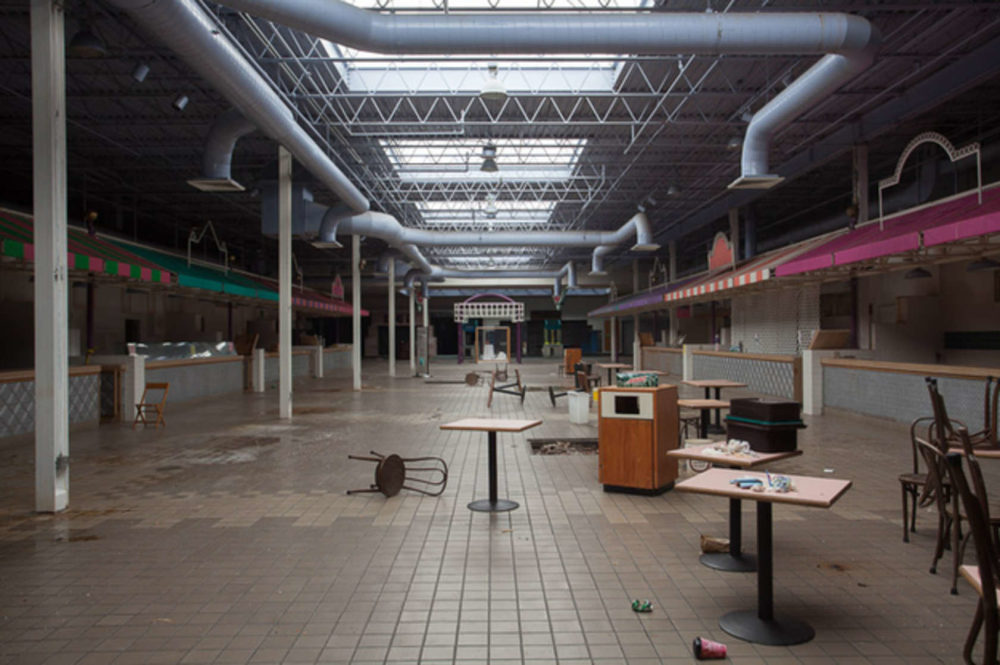
The American shopping mall has always been a symbol of excess. In at least one respect, this reputation is justified: There are far too many of them! With 1,200 indoor malls, the United States has twice as many square feet devoted to shopping centers per capita than the rest of the world and six times as many as Europe. Much of this construction happened rapidly during a commercial real estate boom that peaked in the 1990s. Not surprisingly, this proved unsustainable.
Today, about one third of the country’s malls are considered “dead” or “dying,” meaning that at least 40 percent of the stores are vacant. “The malls died for a reason,” said Ellen Dunham-Jones, an architecture professor at Georgia Tech, “We were way over-retailed.” As consumers found alternatives to the mall in online shopping and big-box stores, the redundancy of malls was only intensified.
A languishing economy has also played a major role in the decline of malls. In the mid-1990s, malls were being constructed at the rate of 140 per year in the United States. Yet in 2007 — the year before the start of the Great Recession — no new malls were built at all. This was the first year this happened since the 1950s. Construction has bounced back a bit since then, but not enough to keep pace with closures.
Dead malls have their admirers. The Facebook group Dead Malls Enthusiasts has over 21,000 members. On the Facebook page, members discuss memories of malls gone by. Some users have even created a map that charts the locations of shuttered malls throughout the country. This is an exciting resource for dead-mall tourists, a small but growing demographic.
The real draw of the group, however, are the photos. Like other examples of ruin porn, there is a nostalgia factor at work in the appeal of dead-mall photography. The mall is a symbol of suburban American life, and its decline corresponds to a change in lifestyle, as young people are increasingly drawn to urban centers. The idea of a mall as a commercial hub and public gathering space increasingly feels very 20th century.
Waste is basically built into the idea of malls, which are giant buildings attached to massive parking lots. Unlike the retail space one would find in an urban downtown, malls are not especially flexible. If the shops aren’t being used for retail, it can be difficult to imagine alternate uses for them. This is why vacant malls often stay that way, marring the suburban landscape.
Abandoned malls are not just unfortunate from an aesthetic standpoint, social problems often pop up in the wake of a mall’s failure. “What happens when a mall begins to deteriorate and no longer functions as a mall?” said Richard Rhodes, the President of Austin Community College in Texas. “In the surrounding neighborhoods, you begin to see the crime rate increase, other homes and buildings being vacated. The whole community surrounding it begins to deteriorate.”
Mr. Rhodes has a special stake in the fate of malls. For years, the administrative offices of Austin Community College were located in the Highland Mall, which was named one of America’s most endangered malls by U.S. News and World Report in 2009. By that time, nearly all of the mall’s 1.2 million square feet of interior space was vacant and falling into disrepair. Not a pleasant work environment in the least!
Austin Community College was faced with a choice: Either vacate the mall and let it wallow or try, somehow, to help bring it back from the brink. The college chose the latter, purchasing the mall outright and converting retail spaces into classrooms and computer labs. The college worked with Barnes Gromatzky Kosarek Architects to renovate the space, installing skylights to offset the “bunker” feel so many midcentury malls can have. Seeing the success of the first wave of improvements, the city of Austin poured another $386 million into the project. Now Austin Community College rents out portions of the building to technology companies and other leasers. The building has been reborn as a dynamic mixed-use office and educational space.
“Just since we’ve started construction, we’ve seen the surrounding community improve,” said Rhodes of the renovation. “New businesses opened up, and vacant businesses have been purchased. It’s turning around the local neighborhood.”
Mall restoration projects are slowly gaining ground around the country and beyond. The Cinderella Mall in Englewood, Colorado — once the largest mall in the Western U.S. — has been transformed into Englewood “CityCenter,” a complex that includes residences, municipal buildings, a rail station, and even an art museum. If malls once served as “pseudo downtowns” for poorly planned suburban communities, Englewood has shown that with the proper redevelopment scheme, they can be repurposed as the real thing. This is exciting.
No mall transformation project is more ambitious than what is in store for Oakridge Centre, a mall located just north of the border, in Vancouver, Canada. This renovation, which is being carried out by a team that includes Henriquez Partners, Stantec and Gensler, involves the construction of tall residential towers on top of the 57-year-old building’s flat roof, which will be fitted with greenery to become a public plaza. The $1.5-billion project will also double the amount of retail space available. This plan shows how, with enough imagination, the humble, sprawling mall can be transformed into the bedrock of a vibrant urban downtown.
